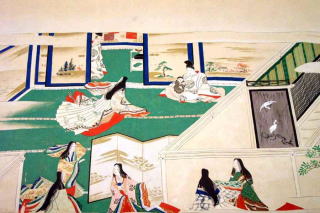1, JAPANESE WRITING
Japanese sentences consist of three kind of letters such as 2,136 Chinese characters (ideogram,
KANJI), and each 48 letters of phonogram, HIRAGANA and KATAKANA.
It is said that Chinese characters were created in China 4,000 years ago as "KOKOTSU MOJI",
which means characters written on turtle shell or bone".
About 4,700 characters were found on bronze tools of 3,500 years ago in China.
On the other hand, Japan did not have letters before the introduction of KANJI characters
through Korean peninsula.
Nihon Shoki, the first chronical compiled by the Imperial Court in 720AD mentions that a Korean
doctor, Wani, introduced 1,000 KANJI characters to Japan around 300 AD.
Afterwards Japanese Buddhist priests created KATAKANA, phonogram in the beginning of
9th century picking up a part of each KANJI character so as to facilitate the reading of Chinese
characters in Buddhist scriptures, while ladies of the Imperial Court created HIRAGANA,
another phonogram in the end of 9th century simplifying each KANJI character for ladies' writing.
All letters of KATAKANA and HIRAGANA only represent sound.
In these days 2,136 KANJI were designated by the Ministery of Education, Culture, Sports, Science
and Technology in 2010 for daily use.
KANJI principally express names and stems of verbs, meanwhile HIRAGANA auxiliary verbs and
participles and KATAKANA foreign names and products. In this way Japanese writing is very
difficult and complicate to master.
However thery are very vusual. When we see words, phrases and/or sentences, we can easily
understand them at a glance.
I would like to show you three kind of letters as follows.
Every letter on the same pillar has same pronounciation as mentioned below.
KANJI 安 以 宇 衣 於 加 幾 久 計 己
HIRAGANA あ い う え お か き く け こ
KATAKANA ア イ ウ エ オ カ キ ク ケ コ
(Pronunciation) a i u e o ka ki ku ke ko
Examples; Chinese letters/hiragana/katakana (pronunciation/meaning)
1, 口 くち クチ (kuchi/mouth)
2, 目 め メ (me/eye)
3, 人 ひと ヒト (hito/man)
4, 山 やま ヤマ (yama/mountain)
5, 川 かわ カワ (kawa/river)
2, JAPAN' S LITERATURE/NOVEL"GENJI-MONOGATARI"
The novel, "GENJI-NOMOGATARI" was wrriten by Ms. Murasaki Shikibu, lady-in-waiting
for the empress Shoko in 1008AD.
This novel is a fictitous story of Prince GENJI, son of concubine of an emperor.
She vividly expresses his saga, romances and way of life at the Imperial Court of 10th century.
Even now it is recognized one of the greatest masterpieces and evaluated as the oldest
in the world. So many literary scholars all over world still study and people read it.
In the Heian Period of 9th to12th century there was a literature salon in the Court with many female
novelists and essayists.
Also, her colleague, Ms. Seisho Nagon wrote an essay "Makura-No-Soshi" which is the oldest
on the globe. In this way many noveles including "Ise-Monogatari", essaies and diaries were written,
too. Murasaki Shikibu and Seisho Nagon also wrote diaries, too.
The Imperial Court literature flourished with many court ladies of Heian dynasty in Japan.
As you may know, Giovanni Boccaccio, Itarian novelist wrote "Decameron" in 1348AD and
Miguel de Cervantes, Spanish noveliest "Don Quijote" in 1605AD.
Both of them are Eurpean immortal masterpieces. However , "GENJI-NOMOGATARI" was written
more than 300 years before than these two works.
Dr. Donald L. Keene, Amarican ivestigator of Japanese culture expresses that the literature of
Heian dynasty is the most sophistcated and elegant of the world history.
And some investigators say that "GENJI-NOMOGATARI" and French novel " A la recherche de
Temps perdu" of 20th century by Mr. Marcel Proust are the supreme masterpices on the globe.

One scene of the Novel, GENJI MONOGATARI
---discontinued---